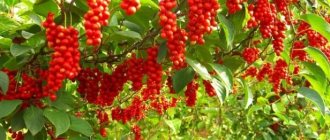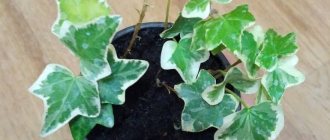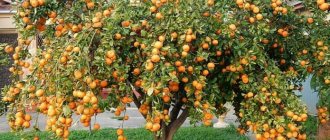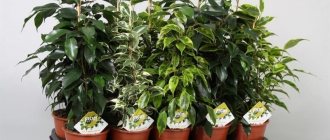Author: Natalya Category: Houseplants Published: August 10, 2017Republished: February 11, 2019Last edits: January 11, 2021
- Apartment care rules
- Mandarin turns yellow
- Propagation by air rooting
- Beneficial features
plant (lat. Citrus reticulata) is a small evergreen tree, a species of the Citrus genus of the Rutaceae family. The fruits of this plant are also called tangerines. The tangerine, the most common species of the genus, comes from Southern Vietnam and China. Currently, the tangerine tree cannot be found in the wild, but it is grown in cultivation in areas with a subtropical climate. And this type of citrus fruit is becoming increasingly popular as a decorative houseplant. In popularity, the homemade tangerine tree is second only to the indoor lemon.
Planting and caring for tangerines
- Flowering: Usually in spring, but can continue all year round.
- Lighting: bright sunlight: a south-facing window sill with shading in the afternoon is best.
- Temperature: in the warm season - from 16 to 30 ˚C, in winter - not lower than 14 ˚C.
- Watering: regular, as the top layer of the substrate dries.
- Air humidity: in hot weather, regular spraying of the plant with warm water and monthly showers are recommended.
- Feeding: during the growing season twice a month with a solution of complex mineral fertilizer. In winter, fertilizing is not needed.
- Dormant period: not clearly expressed, but from about the end of October to mid-February.
- Pinching: the crown is formed within 3-4 years in the spring, at the beginning of active growth: if at a height of 40 cm the seedling does not branch, it is pinched to force the formation of side shoots. Subsequently, the ends of all shoots after the fifth leaf are removed by pinching.
- Reproduction: by seeds, grafting and air layering.
- Pests: spider mites, mealybugs, scale insects and aphids.
- Diseases: root rot.
Read more about growing tangerines below.
Complete fertilizer
In winter, the tangerine tree does not need to be fed, but from mid-spring to autumn, when buds form, it should be fertilized. Food needs to be added 2-3 times monthly. For this purpose, it is recommended to purchase complex preparations containing the following substances:
- nitrogen;
- phosphorus;
- potassium.
You can find good fertilizers in almost any store for gardeners and botanists. It is advisable to give preference to the following means:
- Kemir-lux;
- Uniflor-bud;
- Uniflor growth.
Organic fertilizers should be alternated with mineral ones. Homemade products are made from bird droppings and cow manure. To do this, one part of the dried substance must be diluted in ten parts of clean water, and then the composition must be infused for two to four days.
The soil must be thoroughly moistened before applying fertilizer. If chemicals are used, be sure to follow the instructions, since if the dosage is exceeded, the plant can easily be damaged. In this case, mineral preparations should not come into contact with the fruits of the plant.
Botanical description
Mandarin at home does not reach such a height as in nature, growing only up to 1.5-2 m. The branches of the tree are mostly drooping, the leaves of mandarin are dense, small, elliptical or ovoid, dark green, located on petioles with barely noticeable wings. Single or paired fragrant tangerine flowers with matte white petals are located in the axils of the leaves.
The multi-seeded and multi-lobed mandarin fruit - hesperidium - is covered in a peel that is easily separated from the pulp. It is flattened from top to base and reaches a diameter of 4 to 15 cm. The pulp is yellow-orange in color and consists of a large number of spindle-shaped hairs - sacs filled with juice. The peel of the fruit, which is called “flavedo”, which means “yellow”, contains many glands with essential oil, and its inner white layer, called “albedo” (“white”), is loose, which makes it easy to peel the tangerine. The pulp of a tangerine is usually sweeter and the flavor is stronger than that of an orange. And although the fruits of homemade tangerines are much inferior in taste to the fruits of garden tangerines, a fruiting tangerine, hung like a Christmas tree with yellow-orange balls, looks very attractive.
Growing lemon from seed at home
Indoor tangerine is a spectacular potted plant not only because of its bright, mouth-watering fruits: the flowering of tangerine is also a fascinating sight, especially since it is accompanied by an amazing fragrance. Currently, many amateur gardeners are enthusiastically growing tangerines from seeds just on the windowsill, and we will be happy to tell you how to grow tangerines indoors, how to care for tangerines, how to plant a homemade tangerine, how to protect it from diseases and pests, how to replant tangerine if the pot has become too small for him, and we will also describe the beneficial properties of tangerine.
- Aphelandra at home: care and types
How to transplant a tangerine tree at home?
Proper transplantation of a tangerine tree at home guarantees stable growth and fruiting of the green pet. For young plants, the procedure is carried out annually:
- The best time to transplant is early spring. When flowering, it is better not to stress the plant; it may begin to shed flowers and leaves.
- Choose a pot larger than the previous one by 5-6 cm. You should not buy a container that is too large, as this can lead to a slowdown in growth and rotting of the roots.
- A drainage layer and a small amount of new soil are laid on the bottom of the pots.
- The tree is removed from the old pot and placed into a new one by transshipment.
- All voids are filled with soil.
- The plant is watered abundantly.
- When using store-bought substrate, fertilizing should be resumed only 3-4 weeks after transplantation.
Indoor tangerine from seed
Growing conditions at home
Before planting tangerine seeds, they are wrapped in slightly damp gauze or a napkin for several days. Keep the fabric moist the entire time the seeds are swelling. Instead of gauze or fabric, you can use hydrogel - a product that perfectly retains moisture. Seeds from a freshly eaten tangerine should be sown in the ground immediately, without soaking.
Even if you grow just one tree, soak at least a dozen seeds: firstly, not all of them may germinate, and secondly, some seeds may die from diseases during the growth process, and some seedlings will not survive transplantation.
As soon as the seeds hatch, they are planted in 200 ml cups or in bowls no more than 9 cm deep with drainage holes, filled with a substrate of turf soil (3 parts), humus, sand and leaf soil (1 part each) with the addition of a couple of handfuls of clay. . You will have to prepare the substrate yourself, since any of the purchased soils contain peat, which is contraindicated for tangerines. In extreme cases, you can use Biohumus or Rose soil as a substrate, the pH of which is in the range of 6.5-7.0 units. At the bottom of the cups under the substrate you need to place a layer of expanded clay or small pebbles. The seeds are buried 4 cm in moist soil. The crops are kept at a temperature of 20-25 ºC. Shoots appear within three to four weeks, although this can happen earlier.
If you sowed seeds in a common container, then at the stage of formation of four leaves in the seedlings (citrus fruits do not have cotyledon leaves), you need to pick them out into separate cups. Sometimes two plants can grow from one seed, since multi-germination of seeds is quite common for citrus crops. In this case, the tangerine seedlings need to be carefully separated (each of them has its own root system) and planted. If one seedling is significantly weaker than another, it is better to sacrifice it: pinch it off so that it does not interfere with the development of a stronger plant.
Growing indoor pomegranate - planting and care
The next transplantation of seedlings is carried out when their roots fill the entire volume of the cup. You can use a small pot as a container. Planting a tangerine in a pot is done by transferring the seedling along with a lump of earth.
Tangerine tree - how to plant it?
You first need to plant an indoor tangerine tree from a seed in small containers with a diameter of 5 to 10 cm. Often, ordinary plastic cups or purchased pots and boxes for germinating seedlings are used for these purposes. As the seedling grows, after the appearance of the fifth leaf, it needs to be transplanted into a pot of larger diameter, but not too deep. Then the tree is replanted annually, because the root system of the plant grows very quickly, occupying almost the entire area of the pot.
A tangerine tree in a pot should be planted in light, neutral and nutritious soil. Citrus trees do not tolerate acidic soils, so peat cannot be used. You can buy a ready-made nutrient mixture for citrus fruits in a store or make it yourself from:
- two parts cow humus or compost;
- two parts of a mixture of turf and leaf soil;
- one part of coarse river sand, which has undergone preliminary disinfection.
Caring for a tangerine in a pot
Apartment care rules
The conditions for growing tangerines at home should be as close to natural as possible. Mandarin loves the sun, so the best place for it is a south-facing window, provided that in winter the room temperature does not drop below 14 ºC. In summer, the plant can be kept on a balcony or loggia. However, in the afternoon, tangerines should be protected from sunlight with a curtain made of light fabric or gauze.
The favorable temperature for the development, budding and flowering of tangerine is considered to be from 16 to 18 ºC with an air humidity of 60%. However, do not worry if the room becomes hot with the arrival of summer: tangerines can grow and bear fruit even at 40 ºC.
Watering
Caring for a tangerine involves regularly watering the plant as the top layer of soil in the pot dries. There is a trick to help determine whether a plant needs watering: take a pinch of soil from the pot with your fingers and squeeze it. If the soil sticks together, then it’s too early to water the tangerine, and if it crumbles, then it’s time to moisten the soil in the pot. Under no circumstances allow the earthen ball to dry out completely. Water the tangerine with water at room temperature that has been left standing for 24 hours in an open vessel. In winter, it is advisable to heat water for irrigation to 30-35 ºC, and in summer it can be left in the sun.
As for air humidity, the tangerine, especially in the summer heat, needs daily spraying, and once a month it must be washed in the shower with soap, covering the stem of the plant and the soil in the pot with plastic. This hygienic procedure is also a prevention against pests.
Fertilizer
During the dormant period, in winter, tangerine does not need fertilizing, and during the growing season, a solution of complex mineral fertilizer is added to the soil twice a month. To stimulate abundant fruiting, adult plants 1 m or more in height are fed with fish broth once a month: 200 g of unsalted fish or fish waste is boiled in 2 liters of water for half an hour, allowed to cool and filtered through cheesecloth. Water the soil with “ear” in the morning at an air temperature of 18-19 ºC.
Tangerine transplant
Young plants are replanted annually, fruit-bearing ones - once every 2-3 years, each time increasing the size of the pot in diameter by 4-6 cm. The soil for young plants should be of the following composition: turf soil - 2 parts, and leaf soil, sand and humus - one part at a time. For plants older than three years of turf soil, you need to take three parts, and the remaining ingredients - one at a time. When planting, it is important that the root collar of the tangerine remains at surface level. It is better not to bother replanting very large or old trees, but once every 2-3 years you need to remove the top layer of soil in the pot and replace it with fresh fertile substrate.
Trimming
Mandarin is one of those plants whose crown needs to be shaped. If, with a growth of 30-40 cm, the seedling does not begin to branch on its own, it needs to be pinched to stimulate the formation of side shoots of the first order. However, this is not enough, since fruiting occurs only on branches of the fourth or fifth order. This means that pinching should be continued, removing the ends of all shoots after the fourth or fifth leaf. For sanitary purposes, weak shoots and those growing inside the crown are also pruned. It usually takes 3-4 years for a tree to form.
Sometimes, in order to enhance the branching of shoots, they resort to deflecting and fixing them: one end of a soft wire is fixed on a branch, and the other on the edge of the pot so that the wire pulls the top of the shoot down.
- Shade-loving indoor plants: care
How to propagate a tangerine tree at home?
There are two main ways to propagate tangerines:
- Seed. The entire technology for germinating seeds and planting sprouts was discussed above. It is only worth noting that such a plant must be vaccinated in order to bear fruit. Due to certain difficulties and length of the process, many gardeners prefer to purchase a ready-made seedling. A tangerine tree from a store, as a rule, is already grafted, so it only needs to create favorable conditions for growth.
- Vegetative. A tangerine tree that has been properly cared for at home can be propagated by cuttings. To do this, young shoots with 2-3 leaves are cut off and placed in water with any root-forming solution for several hours. After this, the cuttings are planted in nutrient soil and a greenhouse is built. Rooting will occur within 2-3 months.
Pests and diseases
Mandarin turns yellow
Many amateur gardeners are faced with the fact that tangerine leaves suddenly begin to turn yellow. What is the reason for this phenomenon? There are several reasons. For example, due to a lack of nitrogen in the soil, first the lower leaves of a tangerine become yellow, and then gradually all the foliage turns yellow. This process can be stopped by adding ammonium sulfate, ammonium nitrate or organic matter to the soil.
Against the background of iron deficiency in the soil, tangerine develops chlorosis: first, young leaves acquire a light yellow color, then older foliage becomes discolored. To prevent chlorosis, tangerines are treated with iron chelate once a month.
Another likely cause of yellowing tangerine leaves may be spider mites - tiny arachnids that make punctures in the leaves of the plant and feed on its cell sap. You can only see a mite under a magnifying glass, but sometimes its presence is revealed by the thinnest web appearing on the plant. To destroy pests, wash the tree in the shower, then treat its leaves with a soapy solution: put grated laundry soap in warm water, whip up a thick foam and use a cotton swab to wipe the tangerine leaves with the foam. To completely defeat the tick, you may need three such procedures with an interval of 2-3 days. The place where the mite-infested tangerine stood should be thoroughly washed.
Mandarin leaves turn yellow due to insufficient lighting, as well as because the pot has become too small for the plant.
The tangerine is falling
Leaves falling from a tangerine are not always a sign of any disease. If this happens from late October to mid-February, move the plant to a room with a temperature of 14-17 ºC and reduce watering: the tangerine needs rest. Leaves may also fall due to low air humidity. In this case, the plant should be sprayed in the evenings with settled water at room temperature and containers of water should be placed around it. Tangerine leaves also fall due to improper planting: the plant has a pot that is too large or the root collar is buried in the soil. The cause of leaf falling may be a lack of potassium in the soil, drafts, too wet soil in the pot and poor lighting.
Mandarin is drying
If, before the tangerine leaves begin to fall off, a dry brown crust forms on their edges, we can conclude that the watering regime has been disrupted: you have chronically over-moistened the soil in the pot. To restore normal development of the plant, transplant it into another pot with a good drainage layer and fresh substrate with a predominance of leafy soil. When replanting, carefully inspect the root system of the tangerine and remove rotten roots. Leaves also dry out if there is insufficient watering. A drying plant will have to be revived by placing it in a bowl of water at room temperature. The water in the basin should reach the edge of the pot. Now you need to water the tangerine until the soil is completely wet and air stops coming out of it. After the procedure, drain the excess water and spray the tangerine with a solution of 1 ml of Epin in 2 liters of water. These sprayings should be continued for some time, 2 times a week. In this way, even a very dried out plant can be revived.
Diseases and their treatment
In addition to spider mites, tangerines are also damaged by mealybugs, scale insects and aphids. You need to fight these sucking insects with the same means as you use with mites - a soap solution, after washing the plant well in the shower. Before treating tangerine leaves with foam, do not forget to protect the soil in the pot and the trunk with plastic wrap from soap.
Additional recommendations
Before flowering (in spring), the tree is pruned. Remove all thin and dried branches, as well as yellow leaves. Secateurs must be thoroughly disinfected and sharpened before use. Treat plant sections with tree resin. This will speed up their healing.
Making an oval crown for a tangerine tree is easy. To do this, you just need to trim off excess shoots and pinch out the tops of the branches. During the first flowering of the plant, it is recommended to leave 10-15 buds. It is better to cut off all the rest, as they will absorb too many nutrients and minerals. As the tree matures, you can increase the number of ovaries left.
It is also useful to place wooden supports in the tub, tying branches with fruits to them. Large fruits pull the plant towards the soil, so it can easily break or split.
Citrus needs to be bathed every month. To do this, the pot is covered with polyethylene and placed in the bath. First you need to wet the leaves, then carefully treat them with a soft cloth and soapy water, removing cobwebs and accumulated dust. It is recommended to rinse off the foam under low pressure. The water temperature should be room temperature. Then the branches and leaves should be wiped with a dry cloth and the tree should be left in the bathroom to dry completely. Only after this can the plastic film be removed.
Caring for a tangerine tree is no more difficult than caring for a garden orchid and apple tree. A small amount of water, good lighting and well-chosen fertilizers - and the plant will stretch, and delicate buds and bright leaves will appear on it. In summer, the plant will give you pleasure with a pleasant smell, and in winter it will definitely thank you with healthy and tasty fruits.
Mandarin propagation methods
We have described in detail how to propagate tangerines by seeds. There are other ways to propagate plants - vegetative ones. Unfortunately, it is very difficult to root tangerine cuttings, so we offer you two other ways to propagate this citrus crop.
Propagation by air rooting
Aerial rooting allows you to get a new plant in the form of a large tree that can bloom the next year. Rooting of the shoot is carried out directly on the mother plant. In the spring, select a three- to four-year-old branch from the crown with well-developed shoots growing in all directions, make a 1 cm wide circular cut of bark on it 15-20 cm below the last branch and place a soft plastic pot with a drainage hole cut on one side on the branch. , exactly matching the size of the branch diameter. Sew the cut side with wire and fill the pot: put moss, small shavings or sawdust on the bottom, then sand, and then wet turf-leaf humus with sand (3:1). From the moment the buds swell on the branch, you need to pour 50 ml of a five percent solution of ammonium nitrate into the pot every day. You will know that rooting has occurred by the resumption of leaf growth, but do not rush to separate the rooted branch from the tree: wait until the growth of shoots on it stops and the young leaves ripen.
Instead of a pot, you can use a plastic bag filled with a wet substrate of the described composition, which is soaked in a one percent solution of Heteroauxin. The bag with the substrate is put on the branch at the cut site, and the bag is tied above and below this place.
After about six months, the branch is separated from the tangerine: it is cut off under the bag or under the pot, and when the plastic is removed, another part of the shoot is found that needs to be cut off right under the new root system. After this, the cutting tree is planted in a pot with drainage and nutritious soil and for the first time protected from the sun with white paper. Every day you need to spray the leaves of the seedling with water, and if they suddenly begin to wither, put a large transparent plastic bag on the tree. As soon as the plant restores leaf turgor, the bag is removed from it, but not immediately, but gradually accustoming the tangerine to the conditions of the room.
How to graft a tangerine
The easiest way to graft citrus fruits is budding, that is, inserting a scion bud into the bark of the rootstock. Two- to three-year-old seedlings of citrus crops with a stem as thick as a pencil or slightly more are used as a rootstock, and a varietal tangerine cutting is used as a scion. Budding is carried out on a cloudy day during the period of sap flow: at this time, the bark, exposing the cambium, is easily separated from the wood. A few days before grafting, the rootstock is well watered, and the cutting with the eye is lowered into a vessel with water, having first removed all the leaves from it, but leaving the petioles in the eye.
Select a smooth place on the rootstock 5-10 cm from the ground without thorns and buds and carefully make a shallow T-shaped cut on it (the transverse one is about 1 cm long, and the longitudinal one is 2-3 cm long), slightly pry the edges of the longitudinal cut and turn it back a little bark: in this place you will place the eye of the scion cutting. Now cut off the peephole from the varietal scion (a bud with a petiole protruding from it), using a sharp knife to grab not only the bark, but also a thin layer of wood - the scutellum. There should be 1 cm of bark above the eye, and 1.5 cm below. Take the cut eye by the petiole and insert it into the T-shaped cut of the rootstock, like into a pocket, inserting the shield from top to bottom, then bandage the grafting site from bottom to top with polyvinyl chloride or polyethylene tape.
You can graft two eyes onto one rootstock from different sides of the stem.
- Episcia - care, photos, types
Types and varieties
There are many types and varieties of tangerine. Its varieties are divided into three groups:
- heat-loving noble tangerines, with large leaves and large yellowish-orange fruits in large lumpy skin;
- heat-loving tangerines, or Italian tangerines - not as large-leaved as noble tangerines, with large and slightly elongated orange-red fruits in a plump peel, which sometimes emits a sharp, not very pleasant smell;
- satsumas, or unshiu, are Japanese cold-resistant, large-leaved, seedless tangerines with small, thin-skinned, yellow-orange and green fruits. These plants with a beautiful crown of drooping branches at home reach a height of 1-1.5 m.
There are also many cultural hybrids:
- clementines (orange x tangerine) are very fragrant, small to medium-sized flattened fruits of red-orange color with a thin shiny skin. Multi-seeded hybrids are called Montreals;
- ellendale (tangerine x tangerine x orange) – these orange-red seedless fruits of medium and large size have a refined taste and aroma;
- tangors (tangerine x orange) - flattened red-orange fruits with a diameter of 10-15 cm in a thick, large-porous peel;
- minneola (tangerine x grapefruit) - red-orange fruits of different sizes with an elongated round shape;
- tangelo (tangerine x pomelo) - red-orange fruits the size of an orange;
- santines (clementine x orlando) - fruits with an exquisite taste and aroma, externally reminiscent of noble tangerines;
- agli (tangerine x orange x grapefruit) - flattened and largest of all hybrids fruits with a diameter of up to 18 cm with a large-pore yellow-brown, yellow-green or orange peel.
At home, it is better to grow the following types and varieties of tangerines:
- Unshiu is an early-fruiting, productive, branching and profusely flowering variety, which is a low-growing tree with a spreading crown of corrugated leaves and pear-shaped seedless fruits. Under conditions of additional artificial lighting, this tangerine can grow without ceasing;
- Kovane-wasse is a reluctantly branching, but profusely flowering large tree with thick branches, fleshy, hard leaves and medium-sized orange-yellow fruits;
- Shiva-Mikan is an early ripening, abundantly flowering and fast-growing compact tangerine with dark green fleshy foliage;
- Honey (Murcott) is a rare variety of compact mandarin that ripens in summer and is distinguished by its sweet, honey-like and aromatic fruit pulp.
How to propagate a tangerine tree at home?
There are two main ways to propagate tangerines:
- Seed. The entire technology for germinating seeds and planting sprouts was discussed above. It is only worth noting that such a plant must be vaccinated in order to bear fruit. Due to certain difficulties and length of the process, many gardeners prefer to purchase a ready-made seedling. A tangerine tree from a store, as a rule, is already grafted, so it only needs to create favorable conditions for growth.
- Vegetative. A tangerine tree that has been properly cared for at home can be propagated by cuttings. To do this, young shoots with 2-3 leaves are cut off and placed in water with any root-forming solution for several hours. After this, the cuttings are planted in nutrient soil and a greenhouse is built. Rooting will occur within 2-3 months.
Properties of tangerine - harm and benefit
Beneficial features
What are the benefits of tangerine? Tangerine fruits, rich in vitamins A, D, K, B4, thiamine, riboflavin, rutin, glycosides, phytoncides and essential oils, have a positive effect on the quality of the skin, the functioning of the digestive organs and the nervous system. The fruit pulp contains all types of sugars, ascorbic and citric acids.
The harm and benefits of tangerine have long been studied, and, giving the plant its due, its fruits are called “impeccable citruses.” Scientists believe that the pulp and juice of tangerine fruits:
- increase the tone of the body, therefore they are indicated even for children with high fever;
- quench thirst;
- have an expectorant and antimicrobial effect, therefore they are used in the treatment of asthma and bronchitis;
- stimulate metabolism and increase appetite;
- have antifungal properties;
- effective in the treatment of dysentery;
- help increase the elasticity of capillary walls.
The tangerine peel also has beneficial properties: the tangerine oil it contains is used to eliminate stretch marks on the hips and abdomen, correct wrinkles, and relieve skin inflammation.
Contraindications
For the sake of objectivity, we should also mention the harm of tangerine for people suffering from gastric and duodenal ulcers, gastritis with high acidity, colitis, enteritis, hepatitis, cholecystitis, acute nephritis and other inflammatory diseases of the digestive organs.











